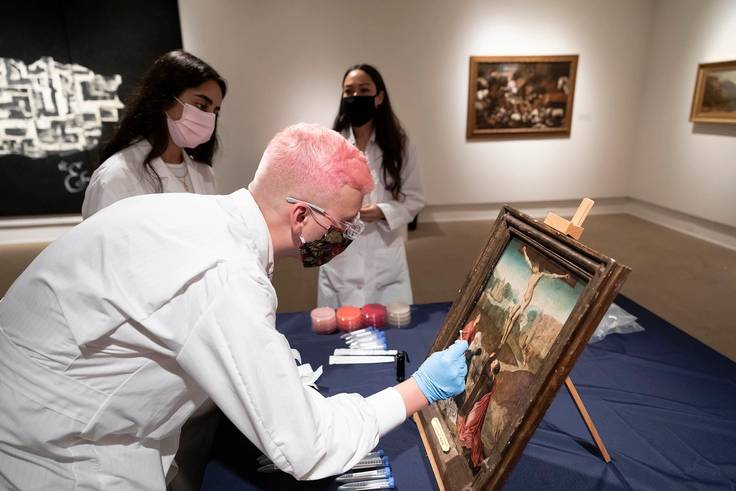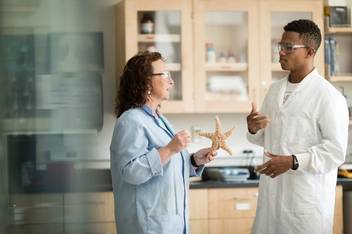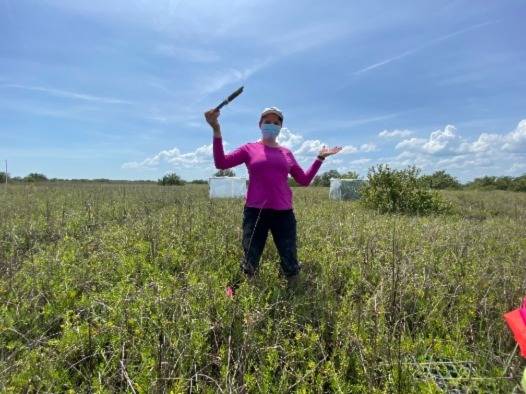Biology Research Projects
There are many opportunities to do original research while you are a student in biology at Rollins.
In addition to smaller research projects within courses, many of our students participate in the Rollins Student-Faculty Collaborative Scholarship Program, spending six to eight weeks on campus working with a sponsoring faculty member. Students also have the option of doing a senior honors research project as part of their degree program.

Explore Previous Student & Faculty Research Projects at Rollins

Microbes & Artwork Biodegradation
The study of the microbiome; the collection of microorganisms that live on and in all existing things, shows that microbes play an important role in human life.
Sarah Hameer '21
Isaac Gorres '21
Faculty Sponsor: Dr. Brendaliz Santiago Narvaez
Microorganisms living on the surface of a painting can contribute to its preservation as well as its degradation. One way in which microorganisms degrade a painting is by using the organic based compounds found in paint as sources of food. Our research aims to identify microorganisms isolated from masterworks showing biodegradation from our campus museum. With our work we hope to identify the microbes that live on the surface of the painting and their unique properties in order to understand the role these microbes play in biodegradation. With this work, students can learn important basic microbiology techniques as well as gain an understanding of how to perform microbiome studies. Students interested in microbiology and art conservation may find particular interest in my research.
Phylogeographic Analysis of Asterias forbesi Glacial Refuge
Study of the phylogeography of the common sea star, Asterias forbesi, in the Northwest Atlantic. This species ranges from about Prince Edward Island in Canada south to Florida.
Damian Clark '19
Faculty Sponsor: Dr. Fiona Harper
As part of this Student-Faculty Collaborative Scholarship Project, Dr. Harper and Damian extracted, amplified and analyzed the sequences of more than 80 sea stars collected from six different locations across the species range. They found some very interesting results and we are currently in the process of writing these up for publication. In particular, they found extremely low genetic diversity in the mitochondrial DNA gene region they sequenced, so much so that some individuals from P.E.I. have the exact same sequence as individuals collected from North Carolina. This lack of genetic diversity is indicative of a genetic bottleneck. One of the implications of this lack of diversity is that if a disease were to arise in this species, the entire range could be susceptible.


Microbial and Meiobenthic Diversity
Zoe Pearson '22
Faculty Sponsor: Dr. Pamela Brannock
Along Florida's Northeast Atlantic coast, shifts in ecosystem structure have been occurring as woody plants encroach upon grassy wetlands due to changing temperatures. Milder winters and less drastic freeze events within this region has allowed the range of mangrove forests to expand northward and displace cordgrass in salt marshes. The Brannock Lab, along with collaborators from a number of different institutions, are trying to understand how this vegetation shift (from cordgrass to mangrove) is impacting benthic communities within this ecosystem. Benthic sediment samples were collected in 2020 and 2021, towards the end of a 3-year in situ experimental set-up. Using metabarcoding and bioinformatics approaches, they determined bacterial and meiobenthic community composition and diversity. By exploring differences in vegetation and temperature treatments, they hope to better understand how the communities are and might change with increased temperatures.
Explore the Fokidis Lab
The Fokidis lab wants to understand how animals perceive and adapt to changes in their environment.
Using integrative and often novel approaches in physiology, students study how hormones and metabolism interact during habitat disruptions and what its implications will be for animal behavior, health, and ultimately populations.
Currently, the research is focused on 3 themes:

1 - The stress physiology of urban animals?
Cities are detrimental to most wildlife, yet a few species can persist or even thrive in even the most "unnatural" landscapes. We study the behavioral and hormonal traits of lizards, turtles and songbirds, to better understand how overcoming your innate stress response may be the “golden ticket” to surviving in the city.
2 - Developing new hormone methods to assist animal conservation?
Studying the health of wild animals can be difficult, especially when dealing with rare or endangered species, or under particular situations. For example, why measure stress hormones in the blood of an animal that has been in a trap all night and is obviously stressed. Our lab has developed new approaches to studying hormones that circumvent such issues to assist conservation initiatives worldwide. Novel sources like claws and leeches, can provide baseline and even retroactive hormone levels that would otherwise be unknown from measuring blood levels. We have also developed remote hair collection methods coupled to infrared cameras that sample hormones from animals that are never caught.
3 - Does food insecurity impact hormonally regulated behaviors?
A ubiquitous challenge that all organisms face is acquiring food resources, and a lack of food universally alters blood levels of various hormones. However, our research has shown that food insecurity can trigger hormone production in organs that do not normally produce them. Such locally synthesized steroid hormones have been described in many species and even in cancer cells, and yet they have unclear roles in the body and even the "trigger" that stimulates this process is unknown. We continue to explore the relationship between these local steroids and an appetite regulator (neuropeptide Y) in both wild cardinals and captive lizards, to determine its effects on aggressive behavior.
